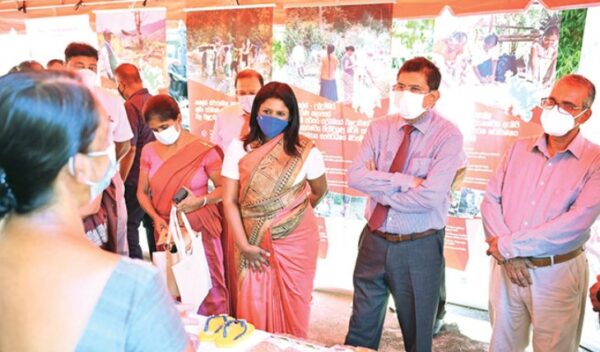Knuckles conservation: Success, lessons showcased at forum-By Ifham Nizam

Dr. Jasinghe having discussions with stakeholders
Source:Island
The United Nations Development Programme’s (UNDP’s) Small Grants Programme (SGP) in the Knuckles Conservation Forest and its Buffer Zone landscape has contributed to the promotion of Agro-ecology, Biodiversity conservation, Soil conservation and Wetlands rehabilitation, said Resident Representative of UNDP in Sri Lanka Robert Juhkam.
Speaking at the Symposium on Strengthening Good Practices and Promoting Policy initiatives in the Knuckles Landscape, GEF-SGP Knuckles Landscape Policy Forum 2022, he said along with the discovery of 10 new endemic herp species which includes six snakes, three amphibians and one skink, a truly remarkable achievement for the project.
“Using a landscape approach where we work with communities and multi stakeholder groups through the lessons learnt, and the dedicated symposiums will aim to highlight, upscale and promote these policy initiatives and results,” he added.
The UNDP also said that encompassing nearly 21,000 hectares, the Knuckles Mountain Range is a biodiversity hotspot and habitat for numerous species endemic to the region. As of 2010, the Knuckles Conservation Forest has formed a part of the designated Central Highlands of UNESCO World Heritage Property, including the Peak Wilderness Protected Area and the Horton Plains National Park.
The Ministry of Environment had played the lead role in the effort by providing national policy guidance to implement the activities with the Non-Governmental Organisations (NGOs) and Community Based Organisations (CBOs) supported by the Global Environmental Facility – Small Grants Programme GEF-SGP in the Knuckles landscape, Environment Ministry Secretary Dr. Anil Jasinghe said.
Dr. Jasinghe said: “The GEF-SGP embodies the very essence of sustainable development through ‘local action, global impacts’, by providing financial and technical support to projects that conserve and restore the environment while enhancing people’s wellbeing and livelihoods.”
He added SGP demonstrated that community action could maintain the delicate balance between human needs and environmental imperatives.
Comprising 35 peaks, this mountainous terrain was identified as a landscape that can enable community-based organizations to take collective actions for adaptive landscape management for socio-economic resilience. Between 2017 and 2021 through its Sixth Operational Phase, GEF-SGP provided grants to 14 community organizations to address biodiversity conservation, land degradation prevention and knowledge management.
The resulting success stories and lessons learnt were showcased at the Knuckles Policy Forum held recently at the Plant Genetic Resource Centre in Gannoruwa, highlighting how communities came forward to safeguard the nature around them, essential for their well-being and livelihoods. The forum was attended by representatives from the Government and State sector, members of the National Steering Committee, Civil Society Organizations, Private Sector, UN and Development sector.
Eco-tourism development initiatives to create sustainable income sources for the communities, and the documentation of traditional knowledge was emphasised as high priority initiatives. Herpetological Foundation Gte. Ltd. (HFSL), Dumbara Mituro Environment & Cultural Foundation, National Ethnic Unity Foundation (NEUF), Arunalu Community Development Centre, Community Development Centre (CDC), Centre for Integrated Indigenous Knowledge Systems (CIIKS), Community Resource Protection Centre (CRPC), Grama Abiwurdhi Foundation for Environmental Conservation (GAFEC), People’s Livelihood Development Foundation (PLDF), Anuruddha Arana Trust (AAT), Integrated Community Development Women’s Federation (ICDWF), Nirmanee Development Foundation, Rangiri Thakshana Piyasa, Sri Lanka Environment Exploration Society (SLEES), were all grantees that willingly empowered their communities to protect and conserve forests while researching and adding new knowledge to the understanding of the richness of the biodiversity of the area.







